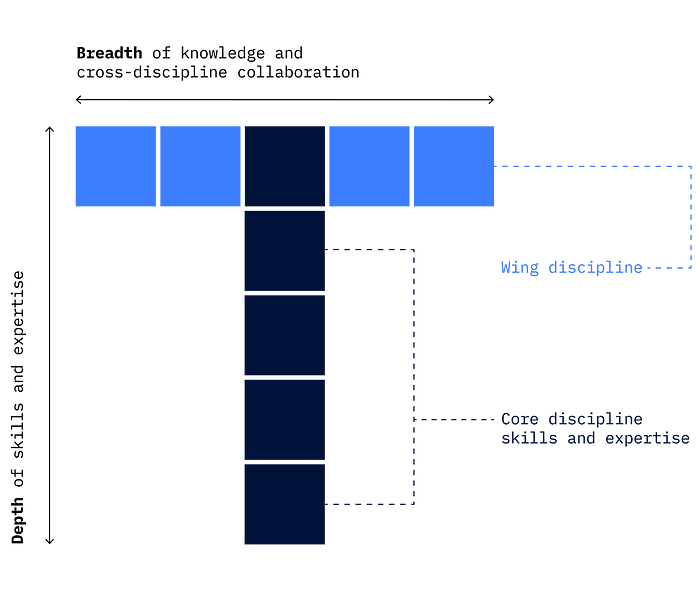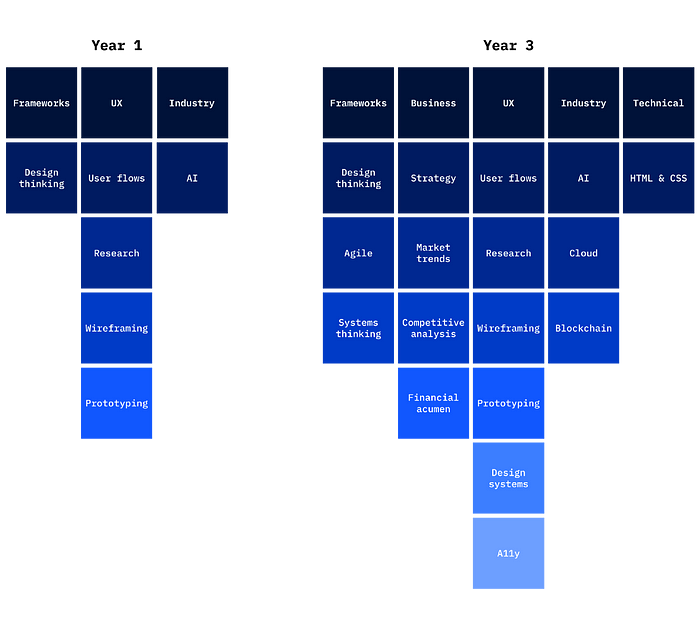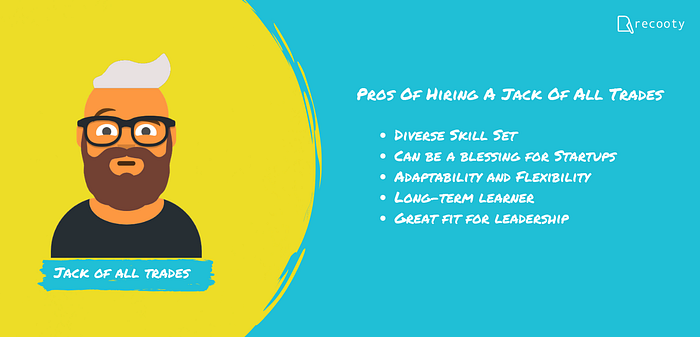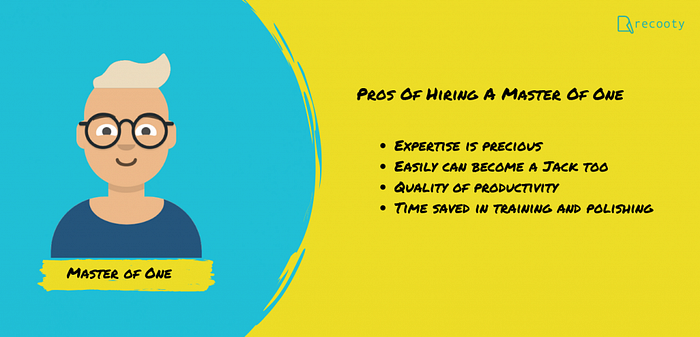

Grow Your T-Shaped Skillset as a UX Designer
source link: https://uxplanet.org/grow-your-t-shaped-skillset-as-a-ux-designer-92e76628f677
Go to the source link to view the article. You can view the picture content, updated content and better typesetting reading experience. If the link is broken, please click the button below to view the snapshot at that time.
Grow Your T-Shaped Skillset as a UX Designer
Become a Jack of All Trades, Master of One
Background
I’ve been working as a UX designer in tech for three years now. But I didn’t start off in the design field.
Back in university, I studied computer science for a year before switching into a digital arts program. The course curriculum covered a range of different topics, including vector art, photography, videography, animation, user research, project management and many more. It was like the buffet of art programs; I got to taste a little bit of everything, but then there was no room to go back for more.
By the end of the program, I decided that out of all the topics I had learned about, I wanted to pursue UX design as a career. The introductory UX classes sparked my interest, but I felt that they were very surface level. I wanted to learn more.
Why am I sharing this with you?
As a new graduate from an arts program, I was excited about the breadth of new skills that I had learned. I could do basic timeline video editing, simple animations in After Effects, work a DSLR camera pretty decently, and even put together a clickable prototype in InVision.
But with all of the skills I had developed, I wasn’t an expert in any of them. I was a jack of all trades, master of none.

Thus, I began teaching myself about design through YouTube tutorial videos and UX Medium articles. I worked on personal projects in my free time to build a portfolio, which helped me learn more about design thinking, user research and improve my skills in using Sketch (before Figma was released).
Only after I decided to hone in on my UX design skills, by a stroke of luck, I had received my first internship offer at IBM.
Interning as a UX designer
Being a member of an enterprise design team, I worked alongside content designers, visual designers, user researchers and front-end developers. Since my role was a UX designer, I focused on learning all I could about user-centred design and following the design thinking process.
In a skills workshop with my manager, I was introduced to the concept of a “T-shaped person”, which changed my perspective on how designers fit into “categories” and how I could approach developing my skills as a designer.
What is a T-shape person?
It is an approach to talent management developed by the CEO of IDEO, Tim Brown.

T-shaped people have two kinds of characteristics, hence the use of the letter “T” to describe them. The vertical stroke of the “T” is a depth of skill that allows them to contribute to the creative process.[…] The horizontal stroke of the “T” is the disposition for collaboration across specialties. […] T-shaped people have both depth and breadth in their skills.
Core discipline skills
As a UX designer, I should focus on growing the depth of my UX skills and expertise. Some of these core discipline skills could include user flows, UX research, wireframing or prototyping. These are the skills that will allow me to contribute my expertise on UX design to the product.
Wing discipline skills
I should also diversify my knowledge of skills into other areas, which would be expected of an enterprise designer. These wing discipline skills could include frameworks (Design Thinking, Agile, Systems Thinking), business acumen (strategy, market analysis and trends, competitive analysis), or industry knowledge (AI, Cloud, Blockchain).
By gaining knowledge in cross-disciplinary skills, I will be able to more effectively collaborate with other design specialties that may be experts in these fields. By learning to speak their language, I can even grow my T to add more depth to some of these skills in the future.

Putting it all together
By identifying my core discipline and wing discipline skills, I was able to see what my strengths were and what I could improve on. As an intern working on a multidisciplinary team, I shifted my perspective away from the categorization of specialties.
Each teammate had strengths in certain skills, but regardless of their discipline, they are all designers whose skillset allows them to work together towards a common goal.
Throughout my internship, I worked on projects that taught me about design systems, mobile design, accessibility and other topics that I didn’t get the chance to learn about in school.
Slowly but surely, I was able to grow the depth and breadth of my T-shape. I believe that adopting this approach to strengthening your skillset is essential to progressing your career as a designer.
Jack of All Trades, Master of One
Now that I’ve been working for a few years, my goal has been to grow my skillset by becoming a “Jack of All Trades, Master of One”. I’ve been gaining expertise in UX design but also diversifying my skillset.

Being a “Jack of All Trades” equips you with a diverse skillset and the ability to adapt to changing environments, which can be especially powerful in a fast-paced startup environment. It also shows that you are open to learning new things, which could spark mentorship or teaching opportunities down the road.

Being a “Master of One” enables you to be an essential part of a team. Someone who attains mastery in one skill can be indispensable to an organization. Often times, it can lead to them wanting to master other skills. Eventually, they can become a “Jack of All Trades, Master of One”.
Takeaways
Whether you begin growing your T-shape horizontally or vertically, the key takeaway is to deepen your core discipline and broaden your wing disciplines to build out your T-shape. Work towards mastering at least one skill and having a toolkit of others that you can draw from.
Look around at your teammates that have a depth in another skill. Ask for mentorship and learn from them. Or take some courses on the side that complement your core discipline. Your skillset will help you continue developing as a UX designer.
Recommend
About Joyk
Aggregate valuable and interesting links.
Joyk means Joy of geeK